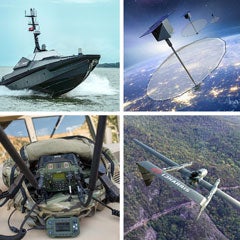Latest Thread
You are using an out of date browser. It may not display this or other websites correctly.
You should upgrade or use an alternative browser.
You should upgrade or use an alternative browser.
L3Harris Technologies USA
- Thread starter Bürküt
- Start date
SUCCESSFUL LAUNCH AND RECOVERY OF AUTONOMOUS UNDERWATER VEHICLE FROM UNDERWAY SUBMARINE
L3Harris, along with industry partners, developed and integrated a homing and docking solution that enabled launch and recovery of an autonomous underwater vehicle (AUV) from an underway submarine, referred to as Torpedo Tube Launch and Recovery (TTL&R).
“We basically started with flashlights and a hoop to teach the vehicle to get into a torpedo tube with a very small (error) margin,” said Daryl Slocum, AUV Technology Director at L3Harris. “From the time we started the project … to actually demonstrating (the capability from) a host in January of this year … took nothing short of a phenomenal team effort.”
Today, L3Harris is the first company to accomplish a fully autonomous launch and recovery of an AUV from an underway submarine, leveraging its proven Iver4 AUV technology. L3Harris is eager to enable the TTL&R capability for real-world missions.
The ability to recover AUVs into an underway submarine enables the host platform to remain covert in safe waters while the AUV is launched to perform surveys and missions in areas that the host platform can’t go. AUVs return with high-fidelity data to be used for tactical and navigational planning and decision-making, delivering manned-unmanned teaming to the fleet.
L3Harris' autonomous capabilities are designed to operate across multiple domains delivering relevant operational advantage in contested environments where manned operations could put sailors and submarines at risk. Its autonomous vehicles and vessels integrate state-of-the-art payloads to detect, track and hold the most challenging threats at risk. L3Harris’ proven capabilities and real-world maritime mission experience demonstrate autonomy’s value to fill today’s operational maritime gaps.
The L3Harris team worked very closely with the U.S. Navy to demonstrate AUV launch and recovery through a challenging test program aboard submarines and Navy support vessels.
“We were able to accomplish something the Navy has been trying to do for (many) years in response to an urgent operational need,” said Slocum.
L3Harris welcomes the continued opportunity to support the Navy in the development of hybrid (manned-unmanned) operational concepts. This new capability will increase operational effectiveness and allow every SSN-class submarine to serve as an AUV mothership.
L3Harris is expanding the undersea advantage and negating threats by working closely with its military and industry partners to develop and rapidly deliver forward-leaning technology for the ‘fight tonight.’ Whether it’s expanding undersea capabilities or developing modular AUVs to support Distributed Maritime Operations – our solutions help maintain dominance in the undersea domain. By advancing new operational concepts, L3Harris is making the oceans transparent to maximize warfighter effectiveness and delivering manned-unmanned solutions today.
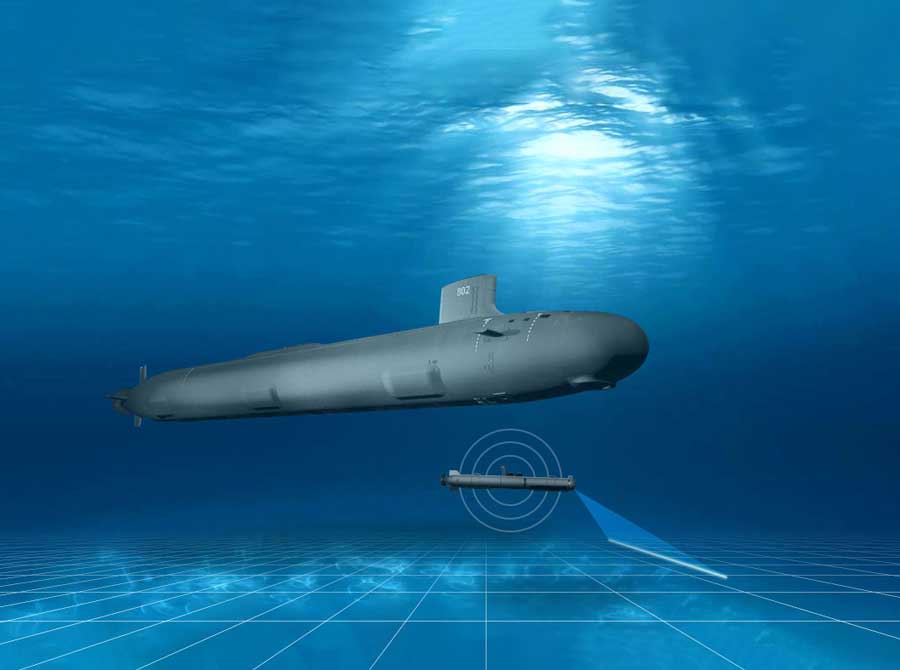
Successful Launch and Recovery of Autonomous Underwater Vehicle from Underway Submarine
L3Harris, along with industry partners, developed and integrated a homing and docking solution that enabled launch and recovery of an autonomous underwater vehicle (AUV) from an underway submarine, referred to as Torpedo Tube Launch and Recovery (TTL&R).
L3HARRIS COMPLETES AEROJET ROCKETDYNE ACQUISITION
MELBOURNE, Fla., July 28, 2023 — L3Harris Technologies (NYSE:LHX) has completed its acquisition of Aerojet Rocketdyne, forming a fourth business segment at the company.
L3Harris signed a definitive agreement to purchase Aerojet Rocketdyne in December 2022, emphasizing its ability to strengthen the defense industrial base, enhance competition and accelerate innovation for a critical merchant supplier of propulsion systems.
“I’m thrilled to welcome more than 5,000 employees to the L3Harris team today,” said Christopher E. Kubasik, Chair and CEO, L3Harris. “With national security at the forefront, we’re combining our resources and expertise with Aerojet Rocketdyne’s propulsion and energetics capabilities to ensure that the Department of Defense and civil space customers can address critical mission needs globally.”
The company also announced Ross Niebergall will serve as President of the Aerojet Rocketdyne segment at L3Harris.
“Our customers demand a competitive environment that produces innovative, agile solutions,” Niebergall said. “We will expand on the strong Aerojet Rocketdyne heritage to enhance production and deliver on those expectations.”
The acquisition diversifies the L3Harris portfolio, adding considerable long-cycle backlog and broad expertise that enables opportunities in missile defense systems, hypersonics and advanced rocket engines, among other areas.
Aerojet Rocketdyne will be known as Aerojet Rocketdyne, an L3Harris Technologies company.
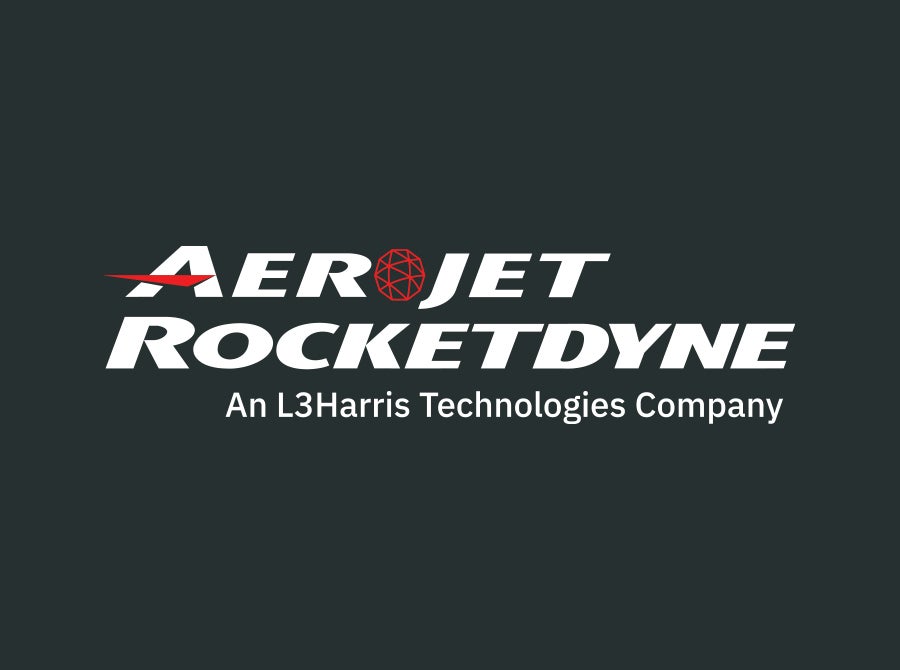
L3Harris Completes Aerojet Rocketdyne Acquisition
L3Harris Technologies has completed its acquisition of Aerojet Rocketdyne, forming a fourth business segment at the company.
L3HARRIS, TEAM LYNX PARTNERS WIN CONTRACT FOR NEXT PHASE OF US ARMY’S MECHANIZED INFANTRY COMBAT VEHICLE PROGRAM
MELBMELBOURNE, Fla., July 31, 2023 — L3Harris Technologies (NYSE:LHX) and its Team Lynx partners, led by American Rheinmetall Vehicles (ARV), won a contract to design and prototype the U.S. Army’s Optionally Manned Fighting Vehicle, now the XM30 Mechanized Infantry Combat Vehicle.
The Lynx team also includes Textron Systems, Raytheon, Allison Transmission and Anduril Industries. Team Lynx will produce a vehicle design then build and test prototypes to increase mobility, lethality and safety for future warfighters. The Army awarded contracts with a value in excess of $700 million to two groups with a final contract expected in 2027.
“We welcome the opportunity to continue working with our partners to produce the most advanced and most secure vehicles for our warfighters,” said Ed Zoiss, President, Space and Airborne Systems, L3Harris. “We are developing innovative technologies that will pave the way for future battlefield dominance. This includes a vehicle with superior protection, unsurpassed firepower and unbeatable mobility that features L3Harris third-generation sights to identify threats better and earlier.”
L3Harris is providing digitally engineered mission systems that adhere to a modular and open-systems approach to lower lifecycle costs. The systems enable battlefield awareness for faster identification and targeting capabilities as well as secure, high-capacity communication systems and data links to improve command and control for collaborative targeting.
The XM30 will replace the M2 Bradley Fighting Vehicle and is the Army’s first ground combat vehicle designed using modern, digital engineering tools and techniques. XM30 is part of the Next Generation Combat Vehicle initiative, which is one of the Army’s top six development and modernization priorities.

L3Harris, Team Lynx Partners Win Contract for Next Phase of US Army’s Mechanized Infantry Combat Vehicle Program
L3Harris Technologies and its Team Lynx partners, led by American Rheinmetall Vehicles (ARV), won a contract to design and prototype the U.S. Army’s Optionally Manned Fighting Vehicle, now the XM30 Mechanized Infantry Combat Vehicle.
L3HARRIS DELIVERS THE FIRST AIRCRAFT OF THE HORNET EXTENSION PROJECT
In June 2023, L3Harris delivered the first fighter aircraft of the Hornet Extension Project (HEP) from its Canadian fighter aircraft center of excellence facility, located in Mirabel, Canada. L3Harris is responsible for much of the design and all of the aircraft’s modifications and upgrades associated with the HEP.
The HEP is a two-phased project that will help ensure Canada’s CF-188 Hornet fleet is able to meet operational commitments, including to the North American Aerospace Defence Command (NORAD) and the North Atlantic Treaty Organization (NATO), until the incoming F-35 next-generation fighter aircraft becomes fully operational in 2032. The initial phase of the project includes modifications for regulatory and interoperability requirements on 94 CF-188s. These adjustments will allow the CF-188s to continue to utilize civilian airspace in the future and to remain interoperable with Canada’s allies. The second phase impacts 36 CF-188s and embodies additional upgraded hardware and software to improve their combat capability to ensure operational viability until the end of service.
For over 35 years, the Royal Canadian Air Force (RCAF) has trusted L3Harris to provide industry-leading in-service support expertise for the sustainment of its fighter aircraft fleet. This includes significant structural life-extension and systems modernization work that has ensured Canada’s fighter fleet remains operationally relevant while extending the value of Canada’s investment in the platform. L3Harris also provides sustainment services on many of Canada’s vital aircraft fleets, such as the CC-150 Polaris; CP-140 Aurora; CH-148 Cyclone; CH-147F Chinook; CT-114 Tutor (Snowbirds) and now the incoming CC-330 fleet, as part of the Canadian government’s Strategic Tanker Transport Capability project.
As a world leader in developing and implementing fighter structural modifications and life-extension solutions, L3Harris has also successfully completed major depot-level programs for the Royal Australian Air Force and the U.S. Navy, as well as provided valuable support to other fighter users, including the Swiss Air Force, the Finnish Air Force and NASA.
"L3Harris is Canada’s only fighter aircraft center of excellence," said Ugo Paniconi, General Manager, L3Harris. "This contract is a testament to our ongoing performance and commitment to our customers’ mission. For over three decades, we have proudly maintained Canada’s only fighter aircraft fleet and we look forward to the opportunity of continuing our rich legacy of ISS on Canada’s future F-35 fleet."
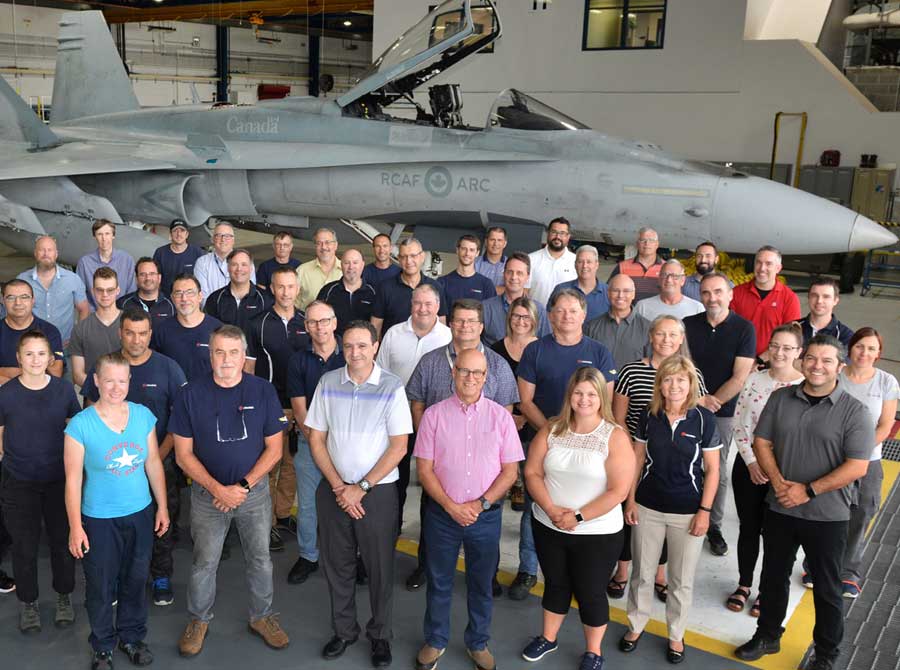
L3Harris Delivers the First Aircraft of the Hornet Extension Project
In June 2023, L3Harris delivered the first fighter aircraft of the Hornet Extension Project (HEP) from its Canadian fighter aircraft center of excellence facility, located in Mirabel, Canada.
MAG AEROSPACE, L3HARRIS TEAM TO EXPAND US ARMY’S AERIAL ISR CAPABILITIES
FAIRFAX, Va. Aug. 22, 2023 — The U.S. Army awarded prime contractor MAG Aerospace and teaming partner L3Harris Technologies (NYSE: LHX) a contract to deliver two enhanced intelligence, surveillance and reconnaissance (ISR) aircraft to support the Army’s Theater-Level, High-Altitude Expeditionary Next Airborne ISR-Radar program known as ATHENA-R.
Integrated on Bombardier Global 6500 aircraft, the system will help the Army meet global intelligence requirements. Operating at high altitude will provide the aircraft greater survivability and line-of-sight, both essential to help the Army achieve its long-range precision fires modernization priorities.
MAG Aerospace is currently the prime contractor for the Army’s Sensor Technology Operations and Readiness (STORM) contract. Being deeply embedded in these critical capabilities is core to MAG’s mission of making the world smaller and safer.
“MAG is honored to support the Army’s ATHENA-R Program. Current geopolitical circumstances dictate a need for an adaptable and resolute ISR solution that can adequately address near-peer threats and future contested environments, and we are prepared to execute,” said Joseph Reale, CEO, MAG Aerospace. “MAG has an exceptional performance history of delivering and managing extensive turnkey aerial C5ISR programs in the most austere and challenging operational environments worldwide. This award is validation of the relentless work our employees execute everyday alongside our customers.”
Designed to close the gap between the Army’s medium and high-altitude ISR aircraft fleet, the ATHENA-R program will provide greater endurance, more payload capacity, longer standoff ranges and leading-edge sensor technology in support of U.S. combatant commands.
“We have a great track record of working with the Army,” said Jon Rambeau, President, Integrated Mission Systems, L3Harris. “Our team understands the urgency of fielding these long-range, deep-sensing capabilities to support the Army’s mission needs and is positioned to deliver.”
Besides winning a contract in September 2022 to develop Phase 2 of the Army’s Multi-Domain Sensing System program, L3Harris supports an additional Army ISR mission: the Airborne Reconnaissance and Electronic Warfare aircraft known as ARES.
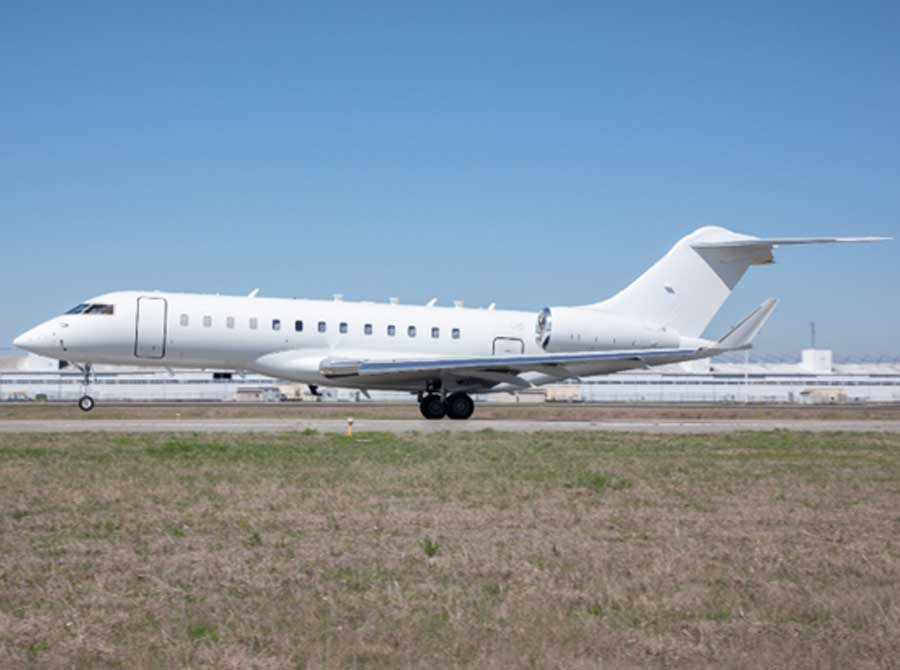
MAG Aerospace, L3Harris Team to Expand US Army’s Aerial ISR Capabilities
The U.S. Army awarded prime contractor MAG Aerospace and teaming partner L3Harris Technologies a contract to deliver two enhanced intelligence, surveillance and reconnaissance (ISR) aircraft to support the Army’s Theater-Level, High-Altitude Expeditionary Next Airborne ISR-Radar program – known...
L3HARRIS, PGZ SIGN MOU TO STRENGTHEN POLISH DEFENSE CAPABILITIES
L3Harris Technologies and Polska Grupa Zbrojeniowa S.A. (PGZ) announced the signing of a Memorandum of Understanding (MOU) intended to enhance communication systems integration and sustainment for the Polish Armed Forces and bolster Poland’s indigenous defense industry.
The MOU furthers collaboration between L3Harris and PGZ with a shared vision of rapid response to Polish defense sector requirements from system development to in-country field maintenance.
As part of the agreement, PGZ subsidiaries Wojskowe Zakłady Łączności Nr 2 S.A. (WZŁ 2) and PIT Radwar S.A., renowned for their defense manufacturing and support expertise throughout Poland, will work toward renewing their status as an authorized in-country maintenance facility for L3Harris tactical radio products. L3Harris further intends to designate WZŁ 2 and PIT RADWAR as preferred in-country installation and integration providers.
"We stand committed to meeting the current and future needs of the Polish Armed Forces, and once we successfully complete the negotiation of definitive agreements, we will formally extend our long-standing relationship with PGZ, WZŁ 2 and PIT RADWAR to foster investment and capabilities that enhance the technological landscape in Poland," said Rick Dickson, L3Harris regional managing director for Central and Eastern Europe. "This MOU represents a great step toward providing our customers with the highest level of support and service for our resilient and interoperable communications solutions."
L3Harris has been supporting the Polish Armed Forces for decades and has plans to expand its presence in the coming years. From a tactical communications perspective, the company has been delivering Falcon® radios since the mid-1990s to Poland’s special forces, land forces and national guard. L3Harris has delivered thousands of radio systems to Poland to date and continues to hire in-country employees and team with local Polish partners.
In addition to the strengthening partnerships and collaboration with local industry, L3Harris plans to expand its presence in Poland and open a facility next year to support advanced electro-optical/infrared engineering and manufacturing.
L3Harris and PGZ subsidiary WZŁ 2 have partnered on numerous defense programs in Poland since 2003. In 2013, WZŁ 2 became certified to perform in-country maintenance of L3Harris NSA-endorsed, high-assurance radios. The companies will also look to expand technology collaboration by leveraging a proven roadmap for industrial localization, which L3Harris has successfully implemented in other regions, including Saudi Arabia.
“PGZ and its subsidiaries are renowned for their defense manufacturing and support expertise throughout Poland, and 20 years of partnership has built mutual trust,” said Dickson. “We have a shared vision of ‘Polonization,’ enhancing technological capabilities and providing superior products and services to the Polish defense sector.”
The MOU marks the beginning of a collaboration demonstrating the commitment of both companies to support and strengthen Poland's defense capabilities, contributing to the nation's security and growth.
"We are proud to join forces with L3Harris," said Kamila Matela, PGZ director of C4 Projects. "This collaboration will bolster our technological capabilities and enable us to contribute significantly to the growth and advancement of the Polish defense sector."
Both companies will work towards commitments on definitive commercial agreements in the following months that will further strengthen the defense industry in Poland and foster enduring cooperation between L3Harris and PGZ.
“We are always looking for ways to better support our customers,” said David Taubman, L3Harris Poland regional sales director. “We are proud to be a preferred communications provider to the Polish Armed Forces, and we are in full support of ‘Polonization.’ We are looking forward to exploring the possibility to manufacture our resilient and NATO-interoperable communication equipment and accessories right here in Poland”.
https://www.l3harris.com/newsroom/e...gn-mou-strengthen-polish-defense-capabilities
L3HARRIS EXPANDS EUROPEAN PRESENCE WITH SENSOR MANUFACTURING FACILITY IN POLAND
KATOWICE, Poland, Sept. 7, 2023 — L3Harris Technologies (NYSE:LHX) is expanding its footprint in Europe by creating an advanced electro-optical/infrared (EO/IR) engineering and manufacturing facility in Poland. The site is expected to be operational early in 2024.
The new 2,800-square meter facility will serve Poland, the wider European continent and a range of broader international customers with L3Harris’ advanced EO/IR sensor systems.
“Increasing our presence in Poland provides our European customers with dedicated teams equipped to meet their unique mission needs,” said Dave Johnson, Vice President, International, L3Harris. “Our advanced EO/IR manufacturing facility and increased business presence in the heart of Europe will enable our customers to remain operationally ready while we continue to strengthen our local partnerships.”
The facility will drive cross-functional efficiencies across research and development, engineering and assembly and employ fully trained local technicians to provide advanced repair services and product support.
The investment builds upon L3Harris’ long history of providing field-proven technologies to customers in Poland and aims to employ more than 30 full-time, highly skilled staff in manufacturing, engineering, finance and operations.
The company’s European presence includes offices in Warsaw and significant manufacturing across Europe. In June 2023, L3Harris opened a 5,500-square-meter manufacturing and product support center in Bologna, Italy.
L3Harris has been supporting the Polish Armed Forces for decades and has plans to expand its presence in the coming years. From a tactical communications perspective, the company has been delivering Falcon® radios since the mid-1990s to Poland’s special forces, land forces and national guard. L3Harris has delivered more than 7,000 radio systems to Poland and continues to hire in-country employees and has teamed with industry partners including PGZ.

L3Harris Expands European Presence with Sensor Manufacturing Facility in Poland
L3Harris Technologies is expanding its footprint in Europe by creating an advanced electro-optical/infrared (EO/IR) engineering and manufacturing facility in Poland. The site is expected to be operational early in 2024.
AEROJET ROCKETDYNE TO POWER LOCKHEED MARTIN’S HALO HYPERSONIC WEAPON FOR U.S. NAVY
MELBOURNE, Fla., Sept. 11, 2023 – Aerojet Rocketdyne, an L3Harris Technologies [NYSE:LHX] company, is providing the advanced propulsion system for the hypersonic solution that Lockheed Martin is developing for the U.S. Navy, known as Hypersonic Air-Launched Offensive Anti-Surface Warfare Weapon (HALO).
According to the Navy, HALO is envisioned to be a long-range, carrier-based, air-launched weapon system.
“We are proud to partner with Lockheed Martin on this important capability, supporting the Navy in its mission to keep the seas open and free,” said Ross Niebergall, President, Aerojet Rocketdyne. “By powering weapons that reach farther, faster, we enable warfighters to remain on the offensive, driving the pace of battle and maintaining the advantage.”
Aerojet Rocketdyne provides a broad range of products to support hypersonics, including air-breathing engines, solid rocket motor boosters, warheads and missile defense technologies.

Aerojet Rocketdyne to Power Lockheed Martin’s HALO Hypersonic Weapon for U.S. Navy
Aerojet Rocketdyne, an L3Harris Technologies company, is providing the advanced propulsion system for the hypersonic solution that Lockheed Martin is developing for the U.S. Navy, known as Hypersonic Air-Launched Offensive Anti-Surface Warfare Weapon (HALO).
BAE SYSTEMS AND L3HARRIS DELIVER FIRST EC-37B COMPASS CALL AIRCRAFT TO THE US AIR FORCE
HUDSON, N.H., and WACO, Texas, Sept. 12, 2023 — BAE Systems and L3Harris Technologies delivered the first of 10 EC-37B Compass Call aircraft to the U.S. Air Force for formal combined developmental and operational testing. The next-generation system evolves the Air Force’s 40-year mission of employing electromagnetic attack (EA) capabilities in support of U.S. and coalition air, surface, and special operations forces.
Mission system prime BAE Systems produces the Compass Call Airborne Electromagnetic Attack mission system at its Hudson, New Hampshire facility. The system disrupts enemy communications, radars and navigation systems, and suppresses enemy air defenses by preventing the transmission of essential information between adversaries, weapon systems and command-and-control networks.
Platform integration prime L3Harris integrated the EC-130H Compass Call mission system into a modern Gulfstream G550 business jet at its Waco, Texas aircraft missionization center. The EC-37B has increased speed, endurance and high-altitude operation for improved survivability and range to deliver EA effects.
“The delivery of the first EC-37B Compass Call is a major milestone for our customer’s electromagnetic attack capabilities,” said Dave Harrold, Vice President and General Manager, Countermeasure & Electromagnetic Attack, BAE Systems. “We take pride in delivering this critical EW capability to keep the U.S. at the vanguard for defense and deterrence.”
“Our team accomplished the incredible challenge of migrating the Compass Call mission equipment from the much larger EC-130H and fully integrating it into the Gulfstream G550 platform,” said Jason Lambert, President, Intelligence, Surveillance and Reconnaissance, L3Harris. “As the Air Force sunsets its 40-year-old EC-130H fleet, the cutting-edge EC-37B will empower the customer to continue serving its vital electromagnetic warfare mission for generations to come.”
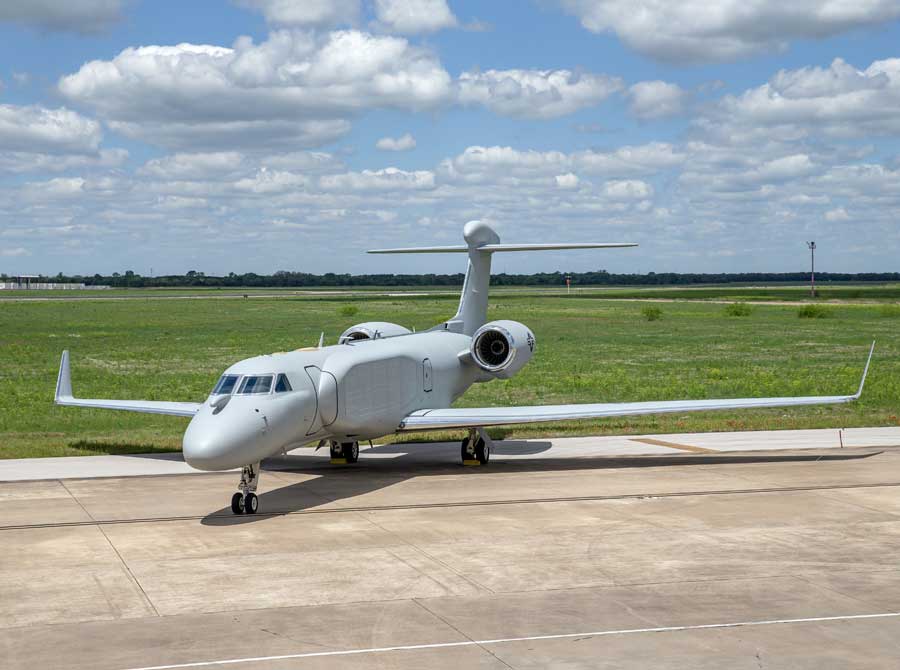
BAE Systems and L3Harris Deliver First EC-37B Compass Call Aircraft to the US Air Force
BAE Systems and L3Harris Technologies delivered the first of 10 EC-37B Compass Call aircraft to the U.S. Air Force for formal combined developmental and operational testing.
AUSTRALIA AWARDS L3HARRIS AUD$328 MILLION MARITIME UNDERWATER TRACKING RANGE CONTRACT
PERTH, Australia, September 20, 2023 — The Australian Department of Defence awarded L3Harris Technologies (NYSE:LHX) a contract, valued at up to AUD$328 million, to deliver new Maritime Underwater Tracking Ranges (MUTR) for the Royal Australian Navy (RAN).
The SEA1350 Phase 3 MUTR program will provide undersea warfare support including a sub-surface tracking capability to aid current and future Australian Defence Force assets, warfighting tactics and proficiency. This program also enables sovereign readiness by safeguarding Australia’s maritime approaches and sea lines of communication.
“We’re committed to growing Australian defence capabilities by leveraging our global technology and experience to develop Australia’s sovereign maritime underwater tracking range approach,” said Alan Clements, Corporate Vice President and Australia Country Executive, L3Harris. “This is an important competence now and into the future as we continue to modernize and enhance maritime platforms and systems.”
Through a series of sensors, the tracking ranges will capture and relay information on the location and movement of assets that are operating within the tracking field. The MUTR will facilitate exercises in deep ocean and littoral waters, involving surface and sub-surface assets simultaneously. The ranges are integral to the Commonwealth being able to swiftly test and evaluate the readiness of platforms and their weapon systems, especially in support of Australia’s strategic shipbuilding program.
L3Harris will build the MUTR in Western Australia and will provide the RAN with sub-surface tracking capability and optimized preparedness. The MUTR will support Australia’s emphasis on anti-submarine warfare capability and enable littoral test and evaluation enhancements through the next decade.
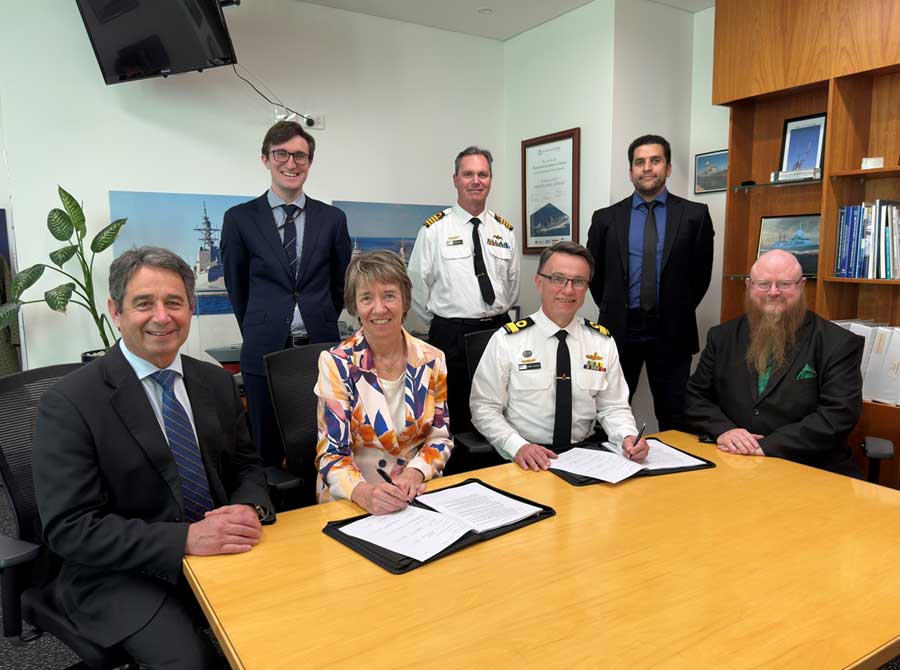
Australia Awards L3Harris AUD$328 Million Maritime Underwater Tracking Range Contract
The Australian Department of Defence awarded L3Harris Technologies a contract, valued at up to AUD$328 million, to deliver new Maritime Underwater Tracking Ranges (MUTR) for the Royal Australian Navy (RAN).
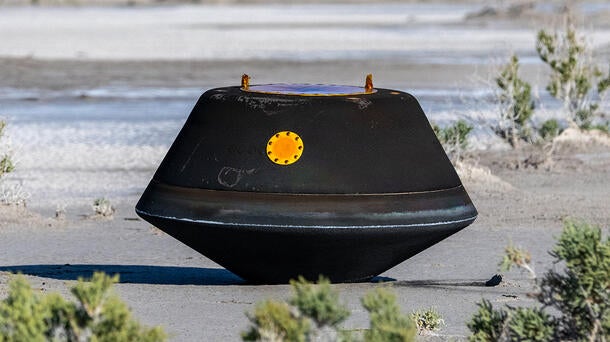
AEROJET ROCKETDYNE-PROPELLED NASA OSIRIS-REX SPACECRAFT SUCCESSFULLY DELIVERS ASTEROID SAMPLE
REDMOND, Wash., Sept. 24, 2023 — Aerojet Rocketdyne, an L3Harris Technologies (NYSE:LHX) company, played a key role in NASA’s successful delivery of the United States’ first asteroid sample to Earth. Aerojet Rocketdyne engines helped propel NASA’s OSIRIS-REx spacecraft throughout its mission - from its launch aboard an Atlas V rocket to asteroid surveillance, sample capture and return.
The OSIRIS-REx spacecraft, built by Lockheed Martin, returned its sample capsule containing material from asteroid Bennu to the Department of Defense’s Utah Test and Training Range. Scientists will study the rocks and dust collected in 2020 from the asteroid’s surface to learn about the formation of our solar system 4.5 billion years ago.
“Our propulsion was invaluable in propelling and steering the spacecraft, as well as returning it safely to Earth,” said Ross Niebergall, President, Aerojet Rocketdyne. “The successful completion of the mission highlights the reliability and performance of our in-space propulsion products.”
Launched atop United Launch Alliance’s Atlas V rocket on Sept. 8, 2016, Aerojet Rocketdyne provided an AJ-60A solid rocket motor, an RL10C-1 Centaur upper stage engine, twelve MR-106 reaction control thrusters on the Centaur upper stage and six pressurized Helium tanks. Aerojet Rocketdyne is the sole spacecraft propulsion provider, providing all 28 rocket engines onboard the OSIRIS-REx spacecraft, including four 60-lbf MR-107S, six 5-lbf MR-106L, 16 1-lbf MR-111G and two 0.02-lbf MR-401 engines.
OSIRIS-REx’s seven-year mission took the spacecraft over 1.4 billion miles, relying on a series of positioning maneuvers dependent on Aerojet Rocketdyne propulsion. NASA has extended the spacecraft’s mission, renaming it OSIRIS-APEX, and it will explore another asteroid, Apophis. In 2029, when Apophis passes near Earth, the spacecraft will use Aerojet Rocketdyne propulsion to keep pace with the asteroid and enter its orbit.

Aerojet Rocketdyne-Propelled NASA OSIRIS-REx Spacecraft Successfully Delivers Asteroid Sample
Aerojet Rocketdyne, an L3Harris Technologies (NYSE:LHX) company, played a key role in NASA’s successful delivery of the United States’ first asteroid sample to Earth. Aerojet Rocketdyne engines helped propel NASA’s OSIRIS-REx spacecraft throughout its mission - from its launch aboard an Atlas V...
US ARMY AWARDS L3HARRIS HMS MANPACK, LEADER RADIO PROGRAM PRODUCTION ORDERS
ROCHESTER, N.Y., Oct. 4, 2023 — The U.S. Army awarded L3Harris Technologies (NYSE:LHX) full-rate Manpack and Leader radio production orders under the Handheld, Manpack & Small Form Fit (HMS) program. These orders, totaling more than $247 million, deliver critical cryptographic modernized communications with resilient waveforms to help ensure the Army’s Integrated Tactical Network can survive in the modern battlespace.
The L3Harris AN/PRC-158 and AN/PRC-163 radios leverage software-defined architectures and integrated cross-banding between waveforms. The radios include key software-defined capabilities that will incorporate satellite communications while on the move.
“Resilient communication is critical now more than ever, as our soldiers face highly sophisticated enemies,” said Sam Mehta, President, Communication Systems, L3Harris. “The technology integrated in our HMS radios allows our soldiers to communicate in the most austere environments. We deliver advanced capabilities, including modern resilient waveforms, to help the warfighter stay connected to their larger teams, whether other users are leveraging our latest-generation devices or assets already in their inventories.”
The radio technology also provides critical airborne platform communications that enhance the connection between ground assets and aerial networks. Under the initiative known as the Air-to-Ground Networking Radio, aircraft will be able to leverage a wide range of resilient waveforms, including SATURN and multiple mobile ad hoc networks, while simultaneously integrating voice and data communications, network routing and gateway functions.

US Army Awards L3Harris HMS Manpack, Leader Radio Program Production Orders
The U.S. Army awarded L3Harris Technologies (NYSE:LHX) full-rate Manpack and Leader radio production orders under the Handheld, Manpack & Small Form Fit (HMS) program.
L3HARRIS, LEIDOS AND MAG AEROSPACE TEAM FOR US ARMY’S HADES AERIAL ISR PROGRAM
MELBOURNE, Fla., Oct. 9, 2023 — L3Harris Technologies (NYSE:LHX), Leidos (NYSE:LDOS) and MAG Aerospace have teamed for the U.S. Army’s High Accuracy Detection and Exploitation System (HADES) program. The companies aim to deliver a fleet of aerial intelligence, surveillance and reconnaissance (ISR) aircraft to rapidly collect relevant and reliable operational intelligence against the nation’s most advanced adversaries.
“We have decades of missionization experience on business jet platforms and our L3Harris, Leidos and MAG Aerospace team brings several years of investment in building, operating and proving the Army’s concept of operations for modern multi-domain missions,” said Jason Lambert, President, Intelligence, Surveillance and Reconnaissance, L3Harris. “No team is more experienced in producing and delivering Army aerial ISR solutions.”
“We’re pleased to bring our expertise in open architecture, aircraft modifications and integrating a wide range of complex mission packages to the L3Harris HADES team,” said Tim Freeman, Senior Vice President and Airborne Solutions Operations Manager, Leidos. “Our proven experience designing and operating the Leidos Special Mission Aircraft for ARTEMIS, together with this team’s capabilities, will help ensure HADES is a success. We look forward to helping deliver an intelligence advantage for the United States and our allies.”
“MAG Aerospace has made substantial investments in the U.S. Army’s next generation, multi-domain ISR platforms as evident by our recent award of the ATHENA-R contract, and we look forward to using our knowledge and experience to help deliver the HADES Program of Record,” said Matt Bartlett, President, MAG Aerospace. “HADES will provide deep sensing solutions as a key enabler to the Army’s Long-Range Precision Fires priority, and we offer the Army the most experienced team to integrate, test, validate, operate and deliver the next generation surveillance platforms.”
The L3Harris-led HADES team brings experience designing, integrating, certifying and operating ISR business jets for the U.S. Army. L3Harris operates a Bombardier Global Series jet as part of the Army’s Airborne Reconnaissance and Electronic Warfare System program supporting U.S. Indo-Pacific Command, while Leidos operates two special mission aircraft for the Army’s Airborne Reconnaissance Targeting and Exploitation Multi-Mission Intelligence System program in support of U.S. European Command.
MAG Aerospace leads the Army’s ATHENA-R program with teammate L3Harris to deliver two enhanced ISR aircraft.
L3Harris is also working on Phase 2 of the Army’s Multi-Domain Sensing System program to develop, build, integrate and demonstrate prototype electronic and communications intelligence sensors onto the new HADES platform.
Each program is expanding the Army’s knowledge of deep sensing solutions to achieve its long-range precision fires modernization priority. Integrated on Bombardier Global 6500 aircraft, the proposed HADES solution will offer greater survivability, capability and coverage in support of U.S. combatant commands.
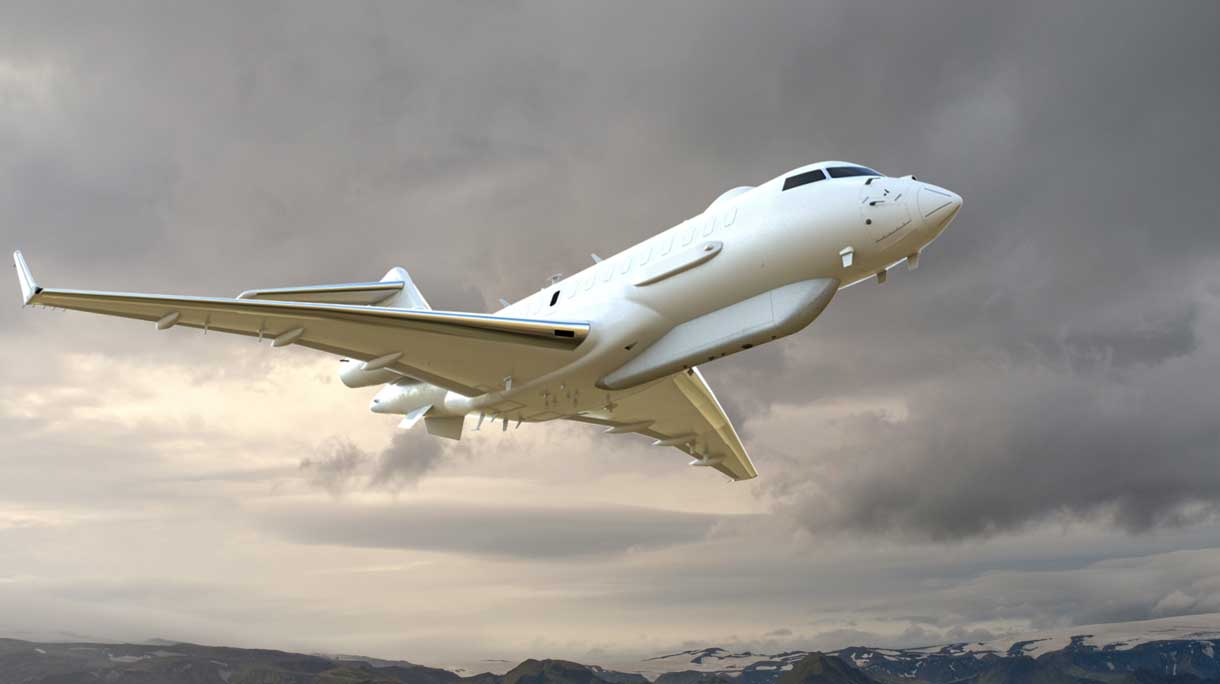
L3Harris, Leidos and MAG Aerospace Team for US Army’s HADES Aerial ISR Program
L3Harris Technologies, Leidos and MAG Aerospace have teamed for the U.S. Army’s High Accuracy Detection and Exploitation System (HADES) program.
L3HARRIS, CREATION TECHNOLOGIES SIGN STRATEGIC PARTNERSHIP AGREEMENT
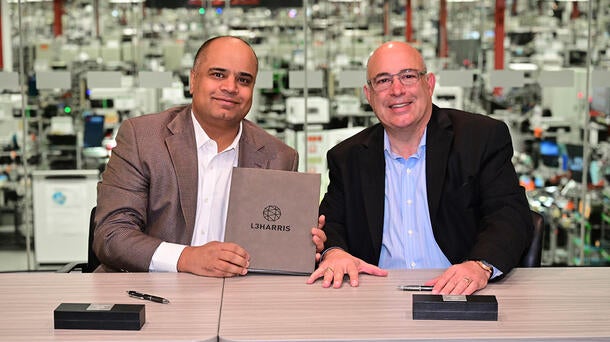
ROCHESTER, New York, Oct. 9, 2023 — L3Harris Technologies (NYSE:LHX) and Creation Technologies Inc. signed a multiyear strategic partnership agreement in support of critical defense and aerospace programs.
The agreement seeks to identify and streamline manufacturing and design processes and improve the capability, agility and competitiveness of the defense industrial supply base.
“This agreement illustrates our commitment to smart acquisition strategies and our relentless focus on providing high-quality products and services at the best value for our military customers,” said Sam Mehta, President, Communication Systems, L3Harris. “Aligned with our performance first focus, this collaboration with Creation strengthens our domestic supply chain by leveraging our combined strengths to meet our customers’ most-demanding missions.”
Creation Technologies provides total electronics product lifecycle solutions, including turnkey design, rapid prototyping, manufacturing and fulfillment, to global customers. Creation has been an L3Harris contract manufacturer for more than a decade, supplying circuit card assemblies, cables and connectors for a multitude of defense programs across L3Harris’ businesses.

L3Harris, Creation Technologies Sign Strategic Partnership Agreement
L3Harris Technologies and Creation Technologies Inc. signed a multiyear strategic partnership agreement in support of critical defense and aerospace programs.
AEROJET ROCKETDYNE PROPULSION INTEGRATED TO NASA’S IMAP SPACECRAFT
The Interstellar Mapping and Acceleration Probe (IMAP), which will investigate two of the most important issues in space physics today, made an important stop at Aerojet Rocketdyne’s site in Redmond, Washington, before its 2025 launch.
As the sole propulsion provider on IMAP, Aerojet Rocketdyne, an L3Harris Technologies company, recently integrated the propulsion subsystem to the spacecraft for the Johns Hopkins Applied Physics Laboratory, who is building the spacecraft and will operate it after launch. IMAP will investigate the acceleration of energetic particles and interaction of the solar wind with the interstellar medium.
"Aerojet Rocketdyne was in top form for this integration,” said Seth Kijewski, IMAP Propulsion Subsystem Lead at APL. “It’s really an exemplary display of what a hardworking, committed team can accomplish.”
The propulsion subsystem is comprised of three propellant tanks, two service valves, two latch valves, two system filters, and 12 MR-111G monopropellant rocket engines modules. Thermal control features were also integrated to the spacecraft. With the completion of this milestone, NASA is now one-step closer to flying the mission.
“During the four-month integration effort, there was a strong customer presence, which made it a very collaborative effort,” said Jack Deboer, IMAP program manager at Aerojet Rocketdyne. “Aerojet Rocketdyne is critical to this program and our thrusters will play a major role in helping scientists understand the risks posed to astronauts and technological systems that fly in space.”
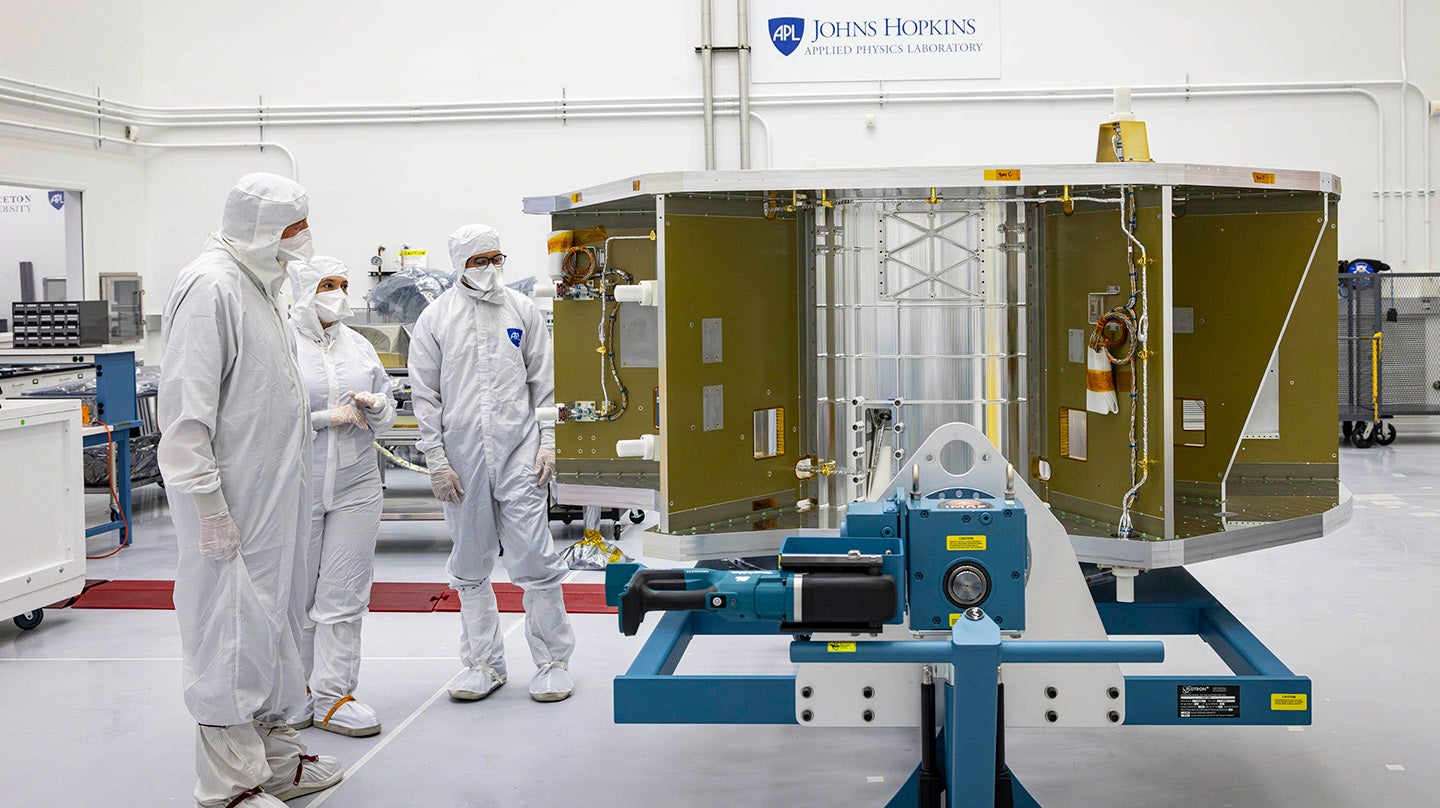
IMAP will explore our solar neighborhood, helping researchers better understand what happens at the boundary of the heliosphere, where the Sun’s protective magnetic influence ends. With its extensive set of 10 instruments, the spacecraft will observe a vast range of particle energies and types in interplanetary space to simultaneously investigate two of the most important overarching issues in heliophysics – the energization of charged particles from the Sun, and interaction of the solar wind with the winds from other stars and other material that fills our galaxy.
IMAP will explore our solar neighborhood, helping researchers better understand what happens at the boundary of the heliosphere, where the Sun’s protective magnetic influence ends. With its extensive set of 10 instruments, the spacecraft will observe a vast range of particle energies and types in interplanetary space to simultaneously investigate two of the most important overarching issues in heliophysics – the energization of charged particles from the Sun, and interaction of the solar wind with the winds from other stars and other material that fills our galaxy.
“Aerojet Rocketdyne delivered the IMAP spacecraft to the customer ahead of the contract schedule,” added Deboer. “Ahead of schedule is always a bonus for a mission that has such an important job to do in understanding and decoding the messages in particles from the Sun and beyond.”
Princeton University professor and principal investigator David J. McComas leads the mission with an international team of 25 partner institutions. APL is managing the development phase, building the spacecraft, and will operate the mission. IMAP is the fifth mission in NASA’s Solar Terrestrial Probes (STP) Program portfolio. The Explorers and Heliophysics Projects Division at NASA’s Goddard Space Flight Center in Greenbelt, Maryland, manages the STP Program for the agency’s Heliophysics Division of NASA’s Science Mission Directorate.
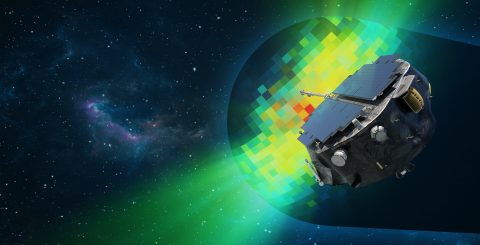
Aerojet Rocketdyne Propulsion Integrated to NASA’s IMAP Spacecraft
Aerojet Rocketdyne Propulsion Integrated to NASA’s IMAP Spacecraft
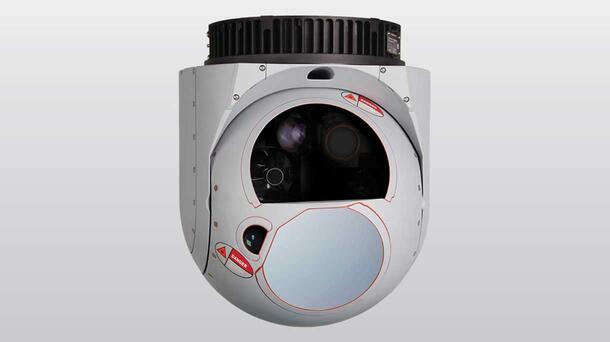
L3HARRIS TO PROVIDE SURVEILLANCE AND TARGETING SYSTEMS FOR NEW REPUBLIC OF KOREA ATTACK HELICOPTER
Korea Aerospace Industries selected L3Harris Technologies to provide surveillance and targeting systems for the Republic of Korea’s new Marine Attack Helicopter.
The L3Harris WESCAM MX™-15D electro-optical/infrared targeting and designating system will provide advanced, battle-tested capabilities for the currently-in-development helicopter, enhancing the RoK’s air, land and marine operations. The highly configurable WESCAM MX-Series EO/IR sensors integrate seamlessly with the helicopter’s target acquisition and designation sights, enabling increased situational awareness.
“This is the first time L3Harris has participated in the initial stages of a new South Korean research and development plan,” said Kristin Houston, President, Electro Optical, L3Harris. “The L3Harris WESCAM MX-15D EO/IR targeting and designating system will provide enhanced, field-proven capabilities for the new helicopter being designed and built by Korea Aerospace Industries. We are proud to partner with KAI and play a part in the advancement of the RoK Marine Corps Aircraft Group.”
Under the new agreement, L3Harris will provide KAI with WESCAM MX-15D EO/IR units for its first development helicopters. L3Harris already provides WESCAM MX-Series EO/IR systems for KAI’s Surion utility helicopters flown by the National Police Agency, Korean Coast Guard and the 119 Fire Fighting Corps. L3Harris also operates a WESCAM Authorized Service Center in South Korea to support its customers locally.

L3Harris to Provide Surveillance and Targeting Systems for New Republic of Korea Attack Helicopter
Korea Aerospace Industries selected L3Harris Technologies to provide surveillance and targeting systems for the Republic of Korea’s new Marine Attack Helicopter.
Last edited:
FVR-90 AIRFRAME SPURS PROTOTYPE FOR U.S. NAVY UNMANNED AIRCRAFT SYSTEM
As the Navy seeks to develop and field advanced unmanned systems, the Naval Air Systems Command’s Small Tactical Unmanned Aircraft Systems Program will look to the FVR-90 to continue VTOL experimentation and maturation efforts due to its tactical mobility and agility.
When deployed at sea, today's unmanned aircraft systems (UAS) have a tall order to fill; they must be capable of operating in harsh maritime environments, capable of hosting a wide variety of payloads and sensors, and deployable from maritime platforms without the need for launch or recovery equipment—all while delivering exceptional endurance and range.
The Navy recently entered into an Other Transaction Authority with L3Harris to partner in developing a new UAS engine based on the FVR-90 airframe. In the coming months, teams from the Navy, L3Harris' Agile Development Group, and Cobra AERO will collaborate to develop a heavy fuel variant of the FVR-90 UAS using the A99 HFE (heavy fuel engine system) that is more capable and agile than those the service currently uses.
The prototype project is a step in the Navy’s longer-term strategy to develop Vertical Take Off and Landing (VTOL) systems that offer greater tactical mobility and do not require launch and recovery equipment. The FVR-90 uses the L3Harris VideoScout® as its control station, a multiband digital data and video communication system, which is already integrated and operational throughout the fleet on numerous U.S. Navy and U.S. Marine Corps Afloat assets, allowing it to integrate onto various vessels.
In addition, L3Harris will be able to demonstrate other company technologies including the CMDL tactical radio and WESCAM MX™-8 EO/IR payload.
"Unmanned systems play an increasingly important role in military tactical and strategic operations, and this project is a big step forward in positioning ourselves for successful mission support against evolving Navy and Marine Corps UAS threats and mission requirements,” said Ed Zoiss President Space and Airborne Systems, L3Harris. "Our system provides a plethora of different capabilities that can be applied to a wide range of operations; from humanitarian assistance, to search and rescue, to surveillance and reconnaissance. The ultimate goal is to provide our warfighters with cutting-edge technologies that enhance their capabilities and keep them safe."
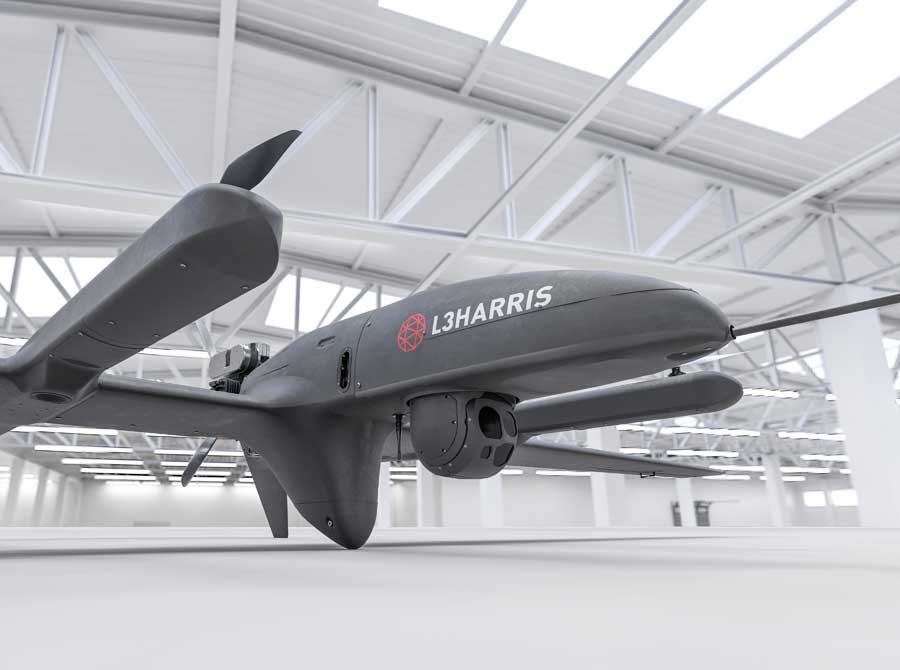
FVR-90 Airframe Spurs Prototype for U.S. Navy Unmanned Aircraft System
As the Navy seeks to develop and field advanced unmanned systems, the Naval Air Systems Command’s Small Tactical Unmanned Aircraft Systems Program will look to the FVR-90 to continue VTOL experimentation and maturation efforts due to its tactical mobility and agility.
L3HARRIS TO ADVANCE DEPARTMENT OF DEFENSE’S SPACE DOMAIN AWARENESS MISSION
MELBOURNE, Fla., Oct. 19, 2023 — L3Harris Technologies (NYSE:LHX) received two contracts worth up to $134 million to update portions of the Department of Defense’s (DoD) space domain awareness mission.
The Ground Based Optical Sensor System (GBOSS) and Space Fence Sustainment (Option Year 4) contracts support the U.S. Space Force’s Maintenance of Space Situational Awareness Integrated Capabilities (MOSSAIC) program.
“Advancing the MOSSAIC program will continue to modernize space domain awareness, which provides critical data to multi-domain warfighting operations,” said Ed Zoiss, President, Space and Airborne Systems, L3Harris. “For National Security Space leadership to respond to threats, they must begin with a clear understanding of the space environment. L3Harris is a key partner through the entire chain of detection, tracking, targeting and engagement options.”
Under the GBOSS contract, L3Harris will design and develop technology to upgrade the existing Ground-Based Electro-Optical Deep Space Surveillance telescopes at the White Sands Missile Range, New Mexico, and Maui, Hawaii, sites. The upgrade will increase GBOSS resiliency and facilitate more persistent coverage supporting space domain awareness across the DoD.
Space Fence is a vital component of the space domain awareness architecture. The Space Fence sustainment program will enable tracking of the objects orbiting Earth, monitoring space weather and assessing foreign launches. L3Harris provides advanced space domain awareness capabilities to help the warfighter detect and attribute potential threatening behavior.

L3Harris to Advance Department of Defense’s Space Domain Awareness Mission
L3Harris Technologies received two contracts worth up to $134 million to update portions of the Department of Defense’s (DoD) space domain awareness mission.
L3HARRIS TO DEVELOP, MODERNIZE ROCKET LAUNCH VEHICLE FIRE CONTROL SYSTEMS FOR US ARMY AND ALLIES
MELBOURNE, Fla., Nov. 1, 2023 — L3Harris Technologies (NYSE:LHX) has received contracts to develop and modernize fire control systems on rocket launch vehicles that help the U.S. Army and allied forces around the world establish battlefield dominance.

Under contracts totaling up to $124 million, L3Harris will provide the Common Fire Control System (CFCS) on both the M142 High Mobility Artillery Rocket Systems (HIMARS) and M270 Multiple Launch Rocket System (MLRS) vehicles produced by Lockheed Martin.
The upgraded fire control units provide enhanced digital processing power and modernized computing infrastructure while eliminating difficult hand assembly and component preparation. L3Harris is increasing CFCS production rates through streamlined supply chain and manufacturing processes to support increased demand driven by the Ukraine conflict.
The L3Harris CFCS combines three vital capabilities for fire control – the Common Launcher Control Unit, Weapon Control Unit and Power Switching Unit. The components are key to allowing operators to control weapons, regulate power and ultimately launch the rockets from the vehicle. The systems are compatible with the M142 HIMARS, a wheeled vehicle, and the tracked M270 MLRS. Providing a common solution for both vehicles reduces lifecycle costs compared to separate systems for each and simplifies production, maintenance, logistics and training.
L3Harris began delivering fire control units for U.S. Army precision ground fire vehicles more than 20 years ago, and the recent agreements are a combination of follow-on orders and new contracts.

L3Harris to Develop, Modernize Rocket Launch Vehicle Fire Control Systems for US Army and Allies
L3Harris Technologies (NYSE:LHX) has received contracts to develop and modernize fire control systems on rocket launch vehicles that help the U.S. Army and allied forces around the world establish battlefield dominance.


